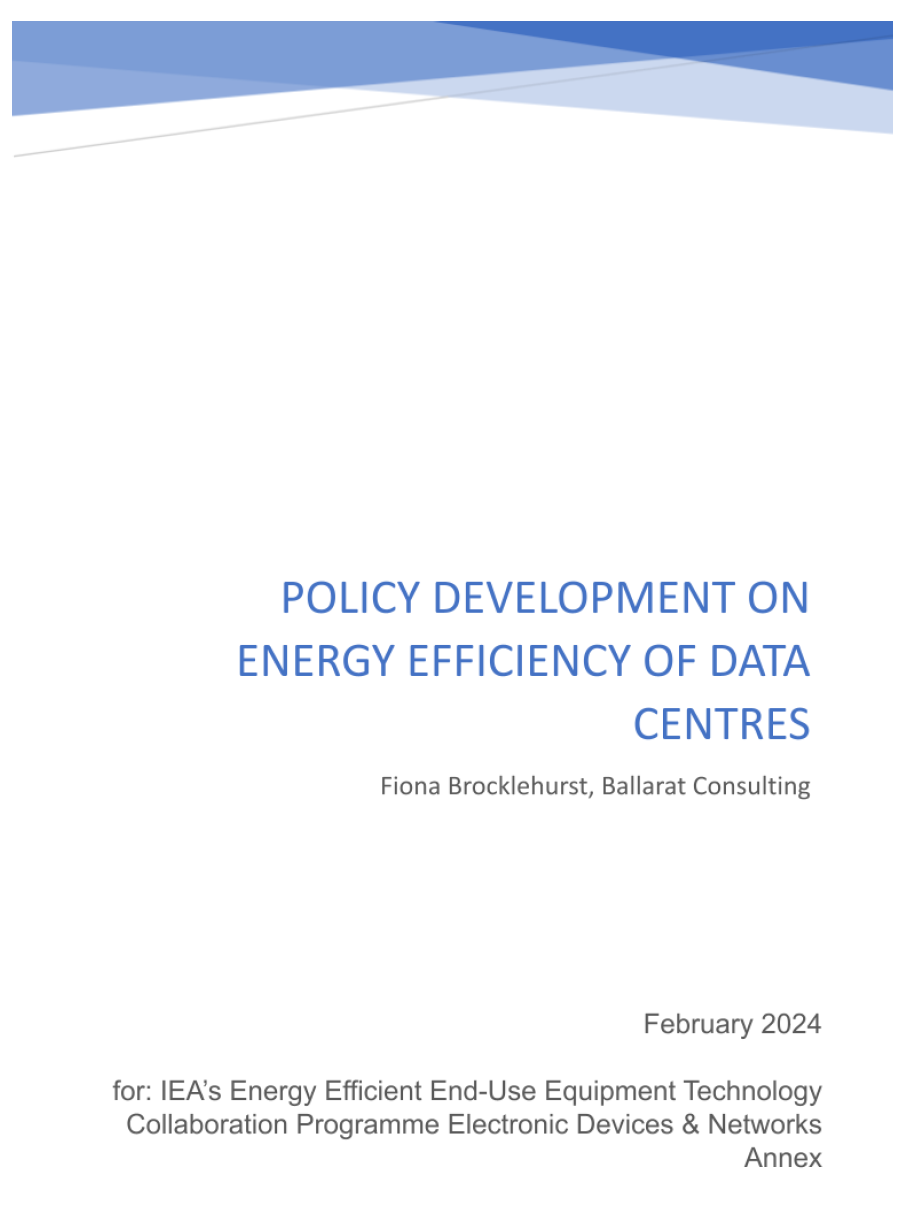Review of policy development on energy efficiency of data centres
Rich Kenny | Feb. 19, 2024

Below is a brief review of the IEA’s Energy Efficient End-Use Equipment Technology Collaboration Programme Electronic Devices & Networks Annex.
Its aims were:
- To provide an overview of policies to increase energy efficiency of data centres and to oblige reporting on the energy use of data centres and
- To estimate the effect of possible policy measures if implemented worldwide using an existing model of data and energy use (the TEM).
Why is it potentially useful?
It looks at a whole raft of legislation and incentives around the data centre sector and where and what they focus on.
The underlying assumption in the report is that current energy use of 230 TWh in 2023 will only increase to 250 TWh in 2030 as increases in energy efficiency will offset the actual growth of services.
Based on the information in the report this seems like a bit of a pipedream since none of the policies actively focus on improving energy efficiency for the IT. While at the same time requiring a 40%+ increase in efficiency to realise the reductions.
The report contains Five energy efficiency measures that were modelled to get an indication of their effect.
The modelled scenarios and measures were:
- Moving data flow/processing from traditional data centres to the cloud
- Reducing energy use by data centre infrastructure
- Increasing high activity utilisation
- Increasing server efficiency
- Increasing equipment shutdown when in low utilisation
- The combination of all five measures with the most stringent PUE.
Expectation is that energy efficiency of servers and hardware will provide a 40%+ reduction in energy consumption by 2025 – from our experience this is entirely possible but incredibly unlikely.
Key challenges:
- Technical Complexity
- Speed of Change
- Lack of suitable metrics – particularly around performance
Current Minimum Energy Performance Standards (MEPS) exist in 4 jurisdictions right now:
- China
- Germany
- France
- Japan
All are focused on PUE reductions so ignore IT efficiency for the most part. This is a known and huge failing of existing legislation and new MEPS are falling into the same problem.
Review of assumptions and programmes:
Efficiency 1 – Move to cloud.
Unfortunately, the report follows the assumption that cloud is always more efficient. This is an issue since cloud utilisation is frequently below a maximum of 40%, often has serious cost implications and security and risk concerns. None of which are mentioned in the analysis.
Efficiency 2 – Reduce PUE
States “PUE is the most widely used sustainability indicator” – while true this is fortunately shifting as PUE is not an efficiency metric that is comparable between locations and doesn’t relate to the efficiency of the IT or performance of services.
Efficiency 3 – Increase utilisation
Recommendation is to increase virtualisation. It is assumed in the paper that virtualisation is not possible in traditional data centres. This is way off. Nearly all servers use virtualisation rather than bare metal.
Efficiency 4 – Increase server efficiency
Assumption that next generation data centres adopt the most efficiency servers as soon as they are available. Possible but no metric on efficiency just assumed that since the servers are new, they are always better. Configuration not mentioned in the report a single time. This is a glaring weakness in nearly all legislation and reporting. There is a large gap in understanding how servers work and serve compute.
Efficiency 5 – Increasing equipment shutdown when in low utilisation
Assumption is that while it is possible it never happens. The model assumes that for next gen and cloud providers this could be increased to 20% from 2025. This is highly unlikely. Cloud providers will not turn off low utilisation servers. Turning off subsequently requires time to boot thereby reducing elastic scalability.
Overview:
The highest impact reduction in the study is around server energy efficiency, accounting for an estimated 45% reduction in energy demand for data centres by 2027. From our experience this is entirely possible, although maybe a little high, based on what we’ve seen the scope of opportunity looks like in many operations.
Paradoxically there is limited legislation aimed at encouragement of mandating this impact. Some procurement policies in public sector nod their head to it but require no validation nor impact assessment prior to purchase.
Key challenges:
- Paucity of data on some parameters – Energy efficiency being the key one
- Lack of suitable metrics – once again energy efficiency
- Complexity of data centres mean there is a greater knowledge gap between suppliers and customers than usually exist for most products and services. Developing procurement guidance or certification schemes should be a priority.
Key legislation:
- China – Minimum Energy Performance Standard – PUE
- Germany – Energy Efficiency Law – PUE, Energy Re-use, Establish an EMS
- Japan – Energy Conservation Act – PUE, Intention to develop an indicator of IT energy efficiency in the future.
- UK – Climate Change Agreement – Discount on carbon taxes – Measurement PUE
- EU – Energy Efficiency Directive EED – All key metrics from the EUCoC – including ITEE